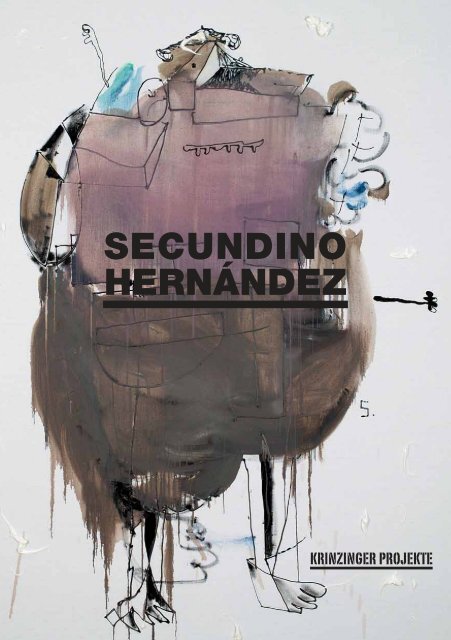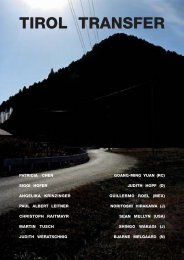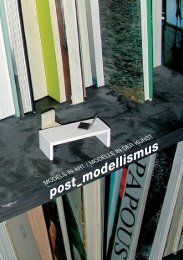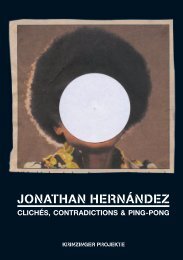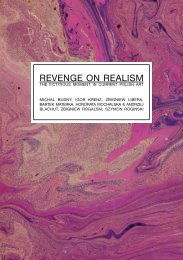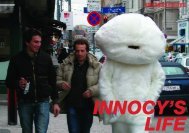Secundino Hernandez 2007 - krinzinger projekte - Galerie Krinzinger
Secundino Hernandez 2007 - krinzinger projekte - Galerie Krinzinger
Secundino Hernandez 2007 - krinzinger projekte - Galerie Krinzinger
Create successful ePaper yourself
Turn your PDF publications into a flip-book with our unique Google optimized e-Paper software.
SECUNDINO<br />
HERNÁNDEZ<br />
KRINZINGER PROJEKTE
SECUNDINO<br />
HERNÁNDEZ<br />
TEXTS PAGE 5<br />
WORKS PAGE 10<br />
BIOGRAPHY PAGE 26<br />
IMPRINT PAGE 27<br />
KRINZINGER PROJEKTE<br />
3
4<br />
Untitled, <strong>2007</strong>, china ink and pastel crayon on paper, 29,7 x 21 cm
A LIFE REMAINS<br />
by Karpov Shelby<br />
The first reaction to exhaustion is a mix<br />
of anger, indignation and rage. After this<br />
initial stage, weariness simply provokes<br />
laughter. Weary laughter, kind or mokking,<br />
which is often capable of transforming<br />
failure into a moral victory.<br />
Painting can be tiring, exhausting and<br />
infuriating. That’s why so many artists,<br />
disoriented at first, tend to internalise<br />
rage and externalise a sense of agony.<br />
But painting can also make you laugh.<br />
Laughing in the face of weariness and<br />
winning hands down. Laughter born of<br />
tedium.<br />
The artist grows weary when he discovers<br />
that it’s impossible to grasp the<br />
object, that drawing the outline of the<br />
object doesn’t serve to contain it.<br />
A nagging sense of ennui ensues as the<br />
painter realizes that the trap he has set<br />
to capture a sense of reality doesn’t<br />
work. It is useless. Painting is a bore<br />
and a drag. When the painter finishes a<br />
painting, in agony and suffering, he<br />
ends up looking like the absurd accomplice<br />
of a complex stupidity. A mirror<br />
hidden in the depths of the painting,<br />
fails to erase the face of the artist who<br />
suspects that rather than making an artwork<br />
he has made a fool of himself. To<br />
put it bluntly.<br />
However, the artist can become skilful.<br />
And if he’s skilful enough, he’ll realize<br />
that, once rage is overcome, laughter<br />
remains. Sincere laughter, springing<br />
from these images of himself, return his<br />
paintings to him. Like a boomerang that<br />
returns in the guise of a landscape complete<br />
with a figure, exaggeration and<br />
caricature. If the painter is sincere in his<br />
endeavour, there is a point when he can<br />
only imagine portraits of gestures that<br />
are roguish, mocking, scandalous and<br />
obscene. Decomposition is followed by<br />
a sense of release. The crass jokes that<br />
ordinary people tell each other after<br />
work. After a hard day of failure, the<br />
doodles, the TV shows and duuuuurty<br />
sex imbue the angry ennui of painting<br />
with a sense of dignity. Theatre of the<br />
grotesque, farces, reflections of oneself<br />
in the bathroom mirror or in the mirror of<br />
the soul. It doesn’t matter which.<br />
In the wake of weariness, pictorial<br />
knowledge – providing it is skilful, as we<br />
said above – creates portraits that make<br />
one laugh, stark naked and with all your<br />
insides hanging out. After a quixotic<br />
gesture, <strong>Secundino</strong> Hernández,<br />
releases us through the flatulence of<br />
Sancho Panza, which serves to make us<br />
human again. The ennui of painting is<br />
juxtaposed with the knowledge of these<br />
bodies that disintegrate into alien extremities,<br />
pictorial gargles. Chronicles of<br />
ennui, of painting, but also of that kind,<br />
generous laughter which, at the end of<br />
the day, gives the individual back a<br />
sense of self.<br />
5
QUEDA UNA VIDA<br />
by Karpov Shelby<br />
La primera reacción contra el agotamiento<br />
es la ira, la indignación y la rabia.<br />
Una vez que se ha superado ese<br />
momento inicial, el cansancio sólo provoca<br />
risa. Una risa cansada, amable y<br />
burlona que, en muchos casos es capaz<br />
de transformar la derrota en una victoria<br />
moral. La pintura cansa, agota e indigna;<br />
por eso hay tantos artistas que, en<br />
un primer momento, desorientados,<br />
caen en la rabia contenida y en el gesto<br />
de agonía. Pero la pintura también da<br />
risa. Una risa capaz de saltarse a la<br />
torera el cansancio y ganar la partida<br />
por la mano. Una risa que nace del cansancio.<br />
Un cansancio que surge cuando el artista<br />
descubre que comprender el objeto<br />
es imposible, que el dibujo de su contorno<br />
no es capaz de contenerlo por<br />
completo. Un cansancio punzante que<br />
aparece con la comprensión de que la<br />
trampa construida para atrapar la sensación<br />
de realidad se cae y no es más<br />
que un cachivache estúpido. Un armatoste,<br />
un tostón... eso es la pintura. Por<br />
eso cansa y da risa. Cuando está terminada,<br />
el pintor, agónico y sufriente, aparece<br />
al fondo siempre como el ridículo<br />
complice de una tontería complicada.<br />
Un espejo que, al fondo del cuadro,<br />
apenas borra la cara de un artista que<br />
se malicia que más que una obra de<br />
arte ha hecho un papelón. Hablando en<br />
plata.<br />
Pero el artista puede llegar a ser hábil. Y<br />
si es hábil, una vez superada la rabia,<br />
sabe que le queda la risa. La risa sincera<br />
que provocan -precisamente- esas<br />
imágenes de sí mismo que le devuelven<br />
sus cuadros. Un boonmerang que vuelve<br />
en forma de paisaje con figura, exageración<br />
y caricatura. Si el pintor es sincero,<br />
a partir de un momento sólo<br />
puede imaginar retratos de gestos burlones,<br />
pícaros, escandalosos y obscenos.<br />
Tras la descomposición, el desahogo.<br />
El chiste chocarrero y sabio que cu -<br />
entan en el bar las personas sencillas<br />
una vez ha terminado su jornada de trabajo.<br />
Tras el amargo jornal del fracaso,<br />
los monigotes, las antenas, y las guarreridas<br />
sexuales devuelven la dignidad a<br />
ese cansancio iracundo de la pintura.<br />
Esperpentos, astracanadas, retratos de<br />
uno mismo en el espejo del baño o en el<br />
espejo del alma. Tanto da.<br />
Tras el cansancio, la sabiduría pictórica<br />
arma – si es hábil, ya decimos- retratos<br />
que dan risa, en pelota picada y con los<br />
entresijos - los higadillos – al aire. Tras<br />
el gesto quijotesco, <strong>Secundino</strong> Her -<br />
nández, nos propone la flatulencia sanchesca<br />
que alivia que devuelve a la vida<br />
interior la medida de lo humano. Al cansancio<br />
de la pintura, contrapone la sabiduría<br />
de estos cuerpos que se desintegran<br />
en extremidades ajenas, en gárgaras<br />
pictóricas. Crónicas del cansancio,<br />
de la pintura, pero también de esa risa<br />
amable y generosa que, al terminar la<br />
jornada, restituye a la persona a su ser.<br />
6
Untitled, <strong>2007</strong>, china ink and pastel crayon on paper, 42 x 29,7 cm<br />
7
SECUNDINO HERNÁNDEZ<br />
by Severin Dünser<br />
<strong>Secundino</strong> Hernández fights against can -<br />
vases like Don Quixote and Sancho<br />
Panza against the windmills. On the one<br />
hand, he joins the fray, on the other hand<br />
he knows how pointless the battle is, yes,<br />
he is aware how illusionary the idea of<br />
the perfect picture is. Already in his early<br />
works he studied how pictures work, how<br />
they are constructed, developed. The process<br />
of creating a picture is essential for<br />
him and takes places in an evolutionary<br />
way. One picture follows another, the next<br />
one being a response to a previous one<br />
and an attempt to im prove it.<br />
He himself compares his painting with co -<br />
pying which takes place so long until the<br />
result has nothing anymore to do with<br />
the initial material. Hernández also testifies<br />
a provisional simplicity to his pictures<br />
– they are imperfect manifestations,<br />
informal fragments, a simple interpretation<br />
– as if someone were whistling Chopin<br />
at the opera. The unfinished should also<br />
prevent the complete inter pretation of the<br />
picture, the impression of the picture is<br />
supposed to remain incomplete. At the<br />
same time the artist leaves us traces on<br />
the canvas – preliminary drawings, corrections<br />
and things he has painted over.<br />
While he seeks in the painting to disrupt<br />
the reception of the depiction, he makes<br />
the working process visible, illustrating<br />
the development of the picture.<br />
The artist also uses a number of quotes<br />
and references. These are obviously re -<br />
ferences and as such they are just as<br />
stereotypic and cliché-like as the comparision<br />
of a Spanish artist with Don<br />
Quixote and Sancho Panza. With this<br />
gesture the artist laughingly throws out<br />
a lure to the beholders. The stereotypic<br />
use of references – be they Kippen berger,<br />
Pollock, Miró or the Surrealists – are sup -<br />
posed to make it easier to read the pictures.<br />
Once the beholder has bitten the<br />
lure the references become irrelevant<br />
and disappear in the complexity of the<br />
entire structure.<br />
At the same time his pictures and figures<br />
all aspire to a lightness, trying to be<br />
genuine in the sense of being obvious.<br />
As such his paintings are once again<br />
draw ings – close to what is essential,<br />
frag ments, painting after a nuclear<br />
explosion, as he refers to it.<br />
Yet none the same the artist’s work in<br />
his studio ends with him making fun of<br />
the pictures he has struggled to create –<br />
with a tragic surrender to the canvas<br />
before once again resuming the battle<br />
the next day. The impossibility of translating<br />
an idea into a form is something<br />
he is aware of. He perceives the inherent<br />
failure as a basic condition of his<br />
output and makes it part of the process<br />
of his creative work.<br />
The main subject of his painting is the<br />
individual, which he makes the object of<br />
his reflections as an entity and prototype<br />
of the self. For Hernández painting is a to<br />
study oneself and to bring it into relation<br />
with an outer reality. Breaking the constraints<br />
of a formal idea is one of his major<br />
concerns in painting, with the re-formation<br />
and re-construction of the human<br />
body serving as methods or approaches.<br />
Mockery, contradiction, absurdity and<br />
entertainment are equal partners in the<br />
artist’s oeuvre. A balance of all these<br />
elements is the basic requirement of a<br />
picture – just as in the history of Don<br />
Quixote which is still entertaining in<br />
spite of all its tragedy.<br />
8
SECUNDINO HERNÁNDEZ<br />
von Severin Dünser<br />
<strong>Secundino</strong> Hernández kämpft gegen Lein -<br />
wände wie Don Quijote und Sancho Panza<br />
gegen die Windmühlen: Einerseits geht er<br />
ins Gefecht, andererseits weiß er um die<br />
Aussichtslosigkeit der Schlacht, ja um die<br />
Illusion des perfekten Bildes. Schon in seinen<br />
frühen Arbeiten beschäftigt er sich da -<br />
mit, wie Bilder funktionieren, wie sie konstruiert,<br />
wie sie entwickelt werden. Der<br />
Pro zess der Bildfindung ist bei ihm essentiell<br />
und geht evolutionär vonstatten, ein<br />
Bild folgt dem anderen, das Kommende<br />
ist Antwort auf das Ver gangene und Stre -<br />
ben nach Verbesserung.<br />
Er selbst vergleicht sein Malen mit dem<br />
Pho to kopieren von Kopien, das solange<br />
gemacht wird, bis das Ergebnis nichts<br />
mehr mit dem Ausgangsmaterial gemeinsam<br />
hat. Auch attestiert Hernández seinen<br />
Bildern eine provisorische Einfachheit – sie<br />
sind unperfekte Manifestationen, lockere<br />
Frag mente, eine plumpe Inter pre ta tion –<br />
als würde man Chopin in der Oper pfeifen.<br />
Das Unfertige soll auch das vollkommene<br />
Auslesen des Bildes verhindern, der Ein -<br />
druck des Blicks soll unvollständig sein.<br />
Gleich zeitig hinterläßt uns der Künstler<br />
Spu ren auf der Leinwand – Vor zeich nun -<br />
gen, Korrekturen und Übermalungen.<br />
Wäh rend er also im Bild die Re zeption des<br />
Abbilds zu brechen versucht, macht er<br />
den Arbeitsprozess sichtbar, die Bildge -<br />
ne se nachvollziehbar. Hinzu kommt die<br />
Verwendung zahlreicher Zitate und second<br />
hand Referenzen. Es sind offensichtliche<br />
Referenzen, und sie sind genauso stereotyp<br />
und klischeehaft wie der Vergleich<br />
eines spanischen Künstlers mit Don<br />
Qui jote und Sancho Panza. Sie sind ein<br />
Augenzwinkern des Künstlers zum Pu bli -<br />
kum hin, ein Wurm am Haken der ausgeworfen<br />
wird. Die stereotype Verwendung<br />
von Bezügen - seien es nun Kippenberger,<br />
Pollock, Miro oder die Sur realisten - soll<br />
den Zugang zu den Bil dern erleichtern.<br />
Wenn der Betrachter erst ein mal angebissen<br />
hat, werden die Ver weise unwichtig<br />
und verschwinden in der Kom plexität der<br />
Gesamtstruktur. Gleich zei tig streben seine<br />
Bilder und Cha raktere eine Leichtigkeit an,<br />
versuchen ehrlich zu sein im Sinne einer<br />
Offen sicht lich keit. So sind seine Malereien<br />
wieder Zeich nungen – nah am Wesen t li -<br />
ch en, Ske lette, Malerei nach der Atom -<br />
explo sion, wie er es be zeich net.<br />
Und trotzdem endet die Arbeit im Atelier<br />
am Abend mit einem Spotten über die Bil -<br />
der, die er sich abgerungen hat – mit einem<br />
tragischen sich der Leinwand Ergeben, um<br />
den Kampf am nächsten Tag wieder aufzunehmen.<br />
Die Unmöglichkeit, eine Idee in<br />
eine Form zu übertragen, ist ihm bewußt,<br />
das Scheitern nimmt er als Bedingung<br />
seiner Arbeit wahr und macht sie zu einem<br />
Teil seines Schaffungs pro zes ses.<br />
Hauptgegenstand seiner Malerei ist der<br />
Mensch, den er als Entität und auch als<br />
Prototyp des Selbst zum Gegenstand seiner<br />
Betrachtungen macht. Die Malerei ist<br />
für Hernández ein Werkzeug, um das Sel -<br />
bst zu erforschen und über die Leinwand<br />
in eine Beziehung zu einer äußeren Realität<br />
zu bringen. Die Brechung des Zwangs ei -<br />
ner formalen Idee ist ihm dabei malerisches<br />
Anliegen, die Re-Formation und Re-<br />
Konstruktion des menschlichen Körpers<br />
sind die methodischen Ansätze.<br />
Spott, Widerspruch, Absurdität und Unter -<br />
haltung sind gleichberechtigte Partner im<br />
Werk des Künstlers und deren Balance die<br />
Grundvoraussetzung für ein Bild – wie auch<br />
in der Geschichte von Don Quijote, die in<br />
all ihrer Tragik doch Vergnügen bereitet.<br />
9
10<br />
Untitled No. 1, <strong>2007</strong>, oil on canvas, 200 x 150 cm
Untitled No. 2, <strong>2007</strong>, oil on canvas, 200 x 150 cm<br />
11
12<br />
Untitled No. 3, <strong>2007</strong>, oil on canvas, 200 x 150 cm
Untitled No. 4, <strong>2007</strong>, oil on canvas, 200 x 150 cm<br />
13
Untitled No. 5, <strong>2007</strong>, oil on canvas, 200 x 150 cm<br />
15
Untitled No. 6, <strong>2007</strong>, oil on canvas, 200 x 150 cm<br />
17
18<br />
Untitled No. 7, <strong>2007</strong>, oil on canvas, 200 x 150 cm
Untitled No. 8, <strong>2007</strong>, oil on canvas, 200 x 150 cm<br />
19
20<br />
Untitled No. 9, <strong>2007</strong>, oil on canvas, 200 x 150 cm
Untitled No. 10, <strong>2007</strong>, oil on canvas, 200 x 150 cm<br />
21
Untitled No. 11, <strong>2007</strong>, oil on canvas, 250 x 190 cm<br />
23
Untitled No. 12, <strong>2007</strong>, oil on canvas, 250 x 190 cm<br />
25
BIOGRAPHY<br />
SECUNDINO HERNÁNDEZ, born 1975<br />
in Madrid, lives and works in Madrid.<br />
Graduated in Fine Arts at the Universi dad<br />
Complutense de Madrid.<br />
SOLO SHOWS<br />
<strong>2007</strong> <strong>Krinzinger</strong> Projekte, Vienna<br />
2006 Hauch!, Galería Heinrich Ehrhardt,<br />
Madrid; Andiamo!, Castello di Ser mo ne ta,<br />
Latina, I<br />
2005 Galería Casaborne, Antequera,<br />
Málaga<br />
2003 Galería Luis Adelantado, Valencia;<br />
Galería Casaborne, Antequera, Málaga<br />
2002 Centro de Arte Joven de la Co mu -<br />
ni dad de Madrid; Galería Espacio F, Ma -<br />
drid; 12 (with Adrián Navarro), Es pa cio<br />
para el Arte Emergente, Madrid<br />
1999 Espacio Fourquet, Madrid; Taller<br />
Alfiz, Madrid<br />
1997 Galería Valle Quintana, Madrid<br />
1994 Taller Alfiz, Madrid<br />
GROUP SHOWS<br />
<strong>2007</strong> Arco 07, Galería Heinrich Ehrhardt;<br />
Art Cologne 07, Galería Heinrich Ehr hardt<br />
& Bärbel Grässlin<br />
2006 La esfera de Pascal, Comunidad<br />
de Madrid; Arco 06, Galería Heinrich Ehr -<br />
hardt; Academia de España, Rome; Art<br />
Cologne 06, Galería Heinrich Ehrhardt<br />
2005 Todos mis amigos han muerto,<br />
Ga lería Casaborne, Antequera, Málaga;<br />
Arco 05, Galería Heinrich Ehrhardt<br />
2004 Arco 04, Galería Heinrich Ehrhardt<br />
& Bärbel Grässlin and Galería Luis Ade lan -<br />
tado, Madrid; Maco 2004, Galería Hein rich<br />
Ehrhardt and Galería Casa bor ne, México<br />
2003 Galería Heinrich Ehrhardt, Madrid;<br />
FIAC 03, Galería Luis Adelantado, París;<br />
2nd Bienal de Pintura de Estocolmo,<br />
Suecia; Miart’03 Galería Luis Ade lan ta do,<br />
Milan; Arco 03, Galería Luis Adelantado,<br />
Madrid; Reducido, Galería Artificial, Ma -<br />
drid; Muestra 2, Galería Luis Ade lan ta do,<br />
México DF<br />
2002 Cara a cara, Galería Luis Adelan ta -<br />
do, Valencia; Galería Artificial, Madrid; XIV.<br />
Edición de Circuitos de Artes Plás ticas y<br />
fotografía de la Comunidad de M adrid;<br />
G a lería Espacio F, Madrid; Casas y cal les,<br />
Lavapiés, Madrid<br />
2000 Homemade, Espacio Fourquet,<br />
Madrid<br />
1999 La Pintura y el Fin de Siglo, Facul -<br />
tad de Bellas Artes de Madrid<br />
1998 Muestra de Arte Joven, Fundación<br />
General de la U.C.M., Facultad de Bel -<br />
las Artes de Madrid<br />
1997 Dèja vu jamaís vu, Galería Barrio y<br />
Valle Quintana, Madrid; El espacio en dos<br />
y tres dimensiones, Fundación Marce li no<br />
Botín Santander; Colectivo PEZ, Estu dio<br />
Pez Privée, Madrid<br />
1996 Poemas y objetos (with David M.<br />
Morán), Taller Alfiz, Madrid<br />
GRANTS AND PRICES<br />
<strong>2007</strong> 1st Price, Generación <strong>2007</strong> de Caja<br />
Madrid; Residency, <strong>Krinzinger</strong> Projekte,<br />
Vienna<br />
2005-06 Grant, Academia de España in<br />
Rome<br />
2004 Price, Generación 2004 de Caja<br />
Ma drid<br />
2003 Youth Price 2003, Fundación Ge -<br />
neral de la Com plutense, Madrid<br />
2002 Grant, Casa de Velázquez, Madrid<br />
2001 Grant, Cursos de Verano de El Es -<br />
corial, Fundación General UCM, Madrid<br />
2000 Erasmus Grant, Academia di Belle<br />
Arti di Brera, Milan<br />
26
IMPRINT<br />
This catalogue is published on the oc -<br />
ca sion of the exhibition of <strong>Secundino</strong><br />
Hernández at <strong>Krinzinger</strong> Projekte,<br />
Vienna, 5 July – 6 October <strong>2007</strong>.<br />
© <strong>2007</strong> by <strong>Krinzinger</strong> Projekte Vienna,<br />
the artist and the writers.<br />
Published by <strong>Krinzinger</strong> Projekte,<br />
Schotten feldgasse 45, 1070 Vienna,<br />
Austria<br />
Idea for the exhibition:<br />
Dr. Ursula <strong>Krinzinger</strong><br />
Exhibition office and technique:<br />
Severin Dünser, Stanislav Piwowarczyk,<br />
Mathias Schönher, Manfred Wiplinger<br />
Editorial office and graphic design:<br />
Severin Dünser<br />
Photos:<br />
Angelika <strong>Krinzinger</strong><br />
Print:<br />
Druckerei Goldstein, Vienna<br />
Cover:<br />
<strong>Secundino</strong> Hernández<br />
Untitled No. 4, <strong>2007</strong><br />
oil on canvas, 200 x 150 cm<br />
KRINZINGER PROJEKTE<br />
Schottenfeldgasse 45 | 1070 Vienna<br />
phone +43.1.512 81 42<br />
galerie<strong>krinzinger</strong>@chello.at<br />
www.galerie-<strong>krinzinger</strong>.at/<strong>projekte</strong><br />
27


